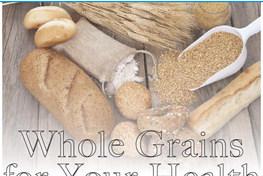Whole Grains for Your Health
Want a healthier diet? Add some whole grains. The Dietary Guidelines for Americans recommend making half your grains whole grains versus refined grains. A grain product is any food made from wheat, rice, oats, cornmeal, barley, farro, quinoa or other cereal grains. Bread, pasta, oatmeal, breakfast cereals, tortillas and grits are among the many foods in the grain group made with whole grains, refined or a combination of the two.
A whole grain is made from the entire grain kernel with the bran, germ and endosperm intact. In a refined grain, the bran and germ have been removed to give the product a longer shelf life and finer texture. Most refined grain products are then enriched, meaning that nutrients like thiamin, riboflavin, niacin and iron that are lost in processing are added back, but the fiber isn’t.
Most of us eat enough total grains, but most are refined rather than whole grains.
Greater whole grain consumption is known to be associated with lower risk of cardiovascular disease. A recent study by Tufts researchers looked at the impact of refined and whole grain intake on specific risk factors: fasting blood glucose levels, waist circumference, systolic blood pressure and blood triglyceride concentration.
The study analyzed information on dietary intake, health and lifestyle of over 3,000 participants in the Framingham Offspring cohort study. When the 18-year data collection period began, these individuals were 55 years old on average and had an average BMI of 27 (on the low end of overweight).
The highest whole grain intake was associated with smaller increases in fasting glucose, waist circumference and systolic blood pressure compared to the lowest intake. Conversely, greater intake of refined grains was associated with greater increases in waist circumference and less decline in triglyceride concentration.
Replacing refined grains (like white rice) and refined grain products (like white bread, white pasta and refined-grain crackers) with whole grains (like barley, quinoa, bulgur and brown rice) and whole-grain products (like whole-wheat breads and pastas and whole-grain crackers) may help middleaged and older adults keep abdominal fat, triglyceride and blood glucose control more stable over time, thereby reducing the risk of cardiometabolic diseases like Type 2 diabetes and heart disease.
The bottom line? If you’re wanting to make a healthy change to your diet, add some whole grains. Switch to brown rice, whole wheat bread, tortillas and pasta, and add quinoa or farro to your salads or as a side dish.
Q and A
Q: I’ve heard omega-3s are good for me. What are they?
A: Omega-3 fatty acids are components of fats. They are considered healthy fats because they support heart health, provide the body with energy and help cells function as they should. There are three main types of omega-3 fatty acids ALA (alpha linolenic acids), found in plant-based foods and vegetable oils, EPA (eicosapentaenoic acids) and DHA (docosahexaenoic acids). Both EPA and DHA have more potent health benefits, including reducing inflammation and aiding in fetal visual and neurological development. EPAs and DHAs are found primarily in fish such as salmon, mackerel, herring and anchovies. They are also in avocados, flaxseed, walnuts and edamame. RECIPE A good, healthy breakfast can start your day right, but it’s often hard to fit in a busy morning. Here’s a recipe for a breakfast scramble from Hy-Vee’s Seasons magazine. If you can spare five or six minutes, breakfast is ready.
BREAKFAST SCRAMBLE Servings: 2 4 large eggs, beaten 1/3 cup chopped fully cooked ham 1/4 cup shredded sharp cheddar cheese 1/2 cup chopped arugula, plus additional for garnish 1/4 cup chopped yellow onion 1/4 cup chopped bell peppers 1/4 cup halved cherry tomatoes 1/2 teaspoon salt-free garlic and herb seasoning blend 1 teaspoon unsalted butter, divided Stir together eggs, ham, cheese, 1/2 cup arugula, onion, bell peppers, 1/4 cup cherry tomatoes and seasoning blend in a medium bowl. Divide egg mixture between two (12-ounce) microwave safe bowls. Add 1/2 teaspoon butter to each bowl. Loosely cover bowls with a paper towel; microwave on high at 1-minute intervals until eggs are set but still moist, stirring each time. Garnish with additional arugula and cherry tomatoes. Serves 2. Note: Other vegetables can be added as well, like asparagus, broccoli, spinach and carrots.
Per serving: 400 calories; 28 grams protein; 7 grams carbohydrates; 29 grams fat (13 grams saturated); 435 milligrams cholesterol; 1 gram fiber; 2 grams sugar (0 grams added); 720 milligrams sodium.
Charlyn Fargo is a registered dietitian with SIU Med School in Springfield, Illinois. For comments or questions, contact her at charfarg@aol. com or follow her on Twitter @ NutritionRD. To find out more about Charlyn Fargo and read features by other Creators writers and cartoonists, visit the Creators website at www.creators.
com.

